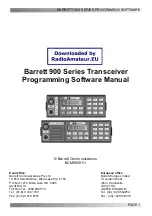
3
TK-480
OPERATING FEATURES
1. Operation Features
The TK-480 is an 800MHz band EFJ LTR™-compatible
trunked radio designed to operate in both trunked and con-
ventional modes. The programmable features are summa-
rized.
Model
Trunking mode
Conventional mode
This model can handle up to 32 systems with up to 250
groups in each system. The transceiver can be used in both
trunked mode and conventional mode. Systems, groups,
and their functions are programmed.
2. Transceiver Controls and Indicators
2-1. Physical Layout
5
4
1
2
3
Microphone
Speaker
6
10
11
12
9
7
8
2-2. Panel controls
The key on the top and front panel is momentary-type
push buttons. The functions of these keys and knob are ex-
plained below.
Antenna connector
Connect the supplied antenna here.
System or Group selector knob (Programmable)
Turning the system (or group) selector knob clockwise
increases the system (or group) number by one. Turning
the knob in the counterclockwise direction decreases the
system (or group) number by one.
After the system number (or group number) reaches the
highest system number (or group number), it goes back
to lowest system number (or group number).
System numbers (or group numbers) not set are skipped.
Caution :
The FPU (KPG-49D (M2) ver 6.30 or later) al-
lows selecting between system selector and group se-
lector.
Volume/Power switch
Transceiver Power and Volume switch. Turn clockwise to
switch On the transceiver. Turn counterclockwise fully to
switch OFF the transceiver. Also adjusts the volume
level. When the power is switched off, all the param-
eters, such as the system and group, are stored in
memory. When the power is switched on again, the sys-
tem returns to the previous conditions.
Auxiliary (orange) key (Programmable)
Battery pack release catch
Push down to release the battery pack. See Installing the
Ni-Cd Battery Pack.
MONITOR key* (Programmable)
PTT (Push-To-Talk) key
Press this key, then speak into the microphone to call a
station.
LAMP key* (Programmable)
TX/BATT indicator
This red LED lights during transmission (it does not light
during busy or when transmit is prohibited). If the battery
voltage falls below the programmed voltage during trans-
mission, the brightness of this indicator decreases at in-
tervals of about one second, so it can be used as the bat-
tery voltage alert function.
S, A, B, and C key (Programmable)
DTMF keypad
Press the keys on the telephone keypad to send DTMF
tones.
Universal connector
Connect the external KMC-25 speaker/ microphone (op-
tional) here. Otherwise, keep the supplied cover in place.
* : MONITOR and LAMP are arbitrary names chosen for
these buttons. They can be used for any of the auxiliary
functions.
2-3. Programmable keys
The FPU (KPG-49D (M2) ver 6.30 or later) enables pro-
grammable keys to select the following functions.
Auto Tel, AUX(only when Voice Scrambler is not se-
lected), DTMF ID (BOT), DTMF ID (EOT), Display Character,
Emergency (only AUX key), Function, Group Down, Group
Up, Home Group, Key Lock, Lamp, Memory (RCL/STO),
Memory (RCL), Memory (STO), Monitor A, Monitor B, Moni-
tor C, Monitor D, Redial, RF Power Lo, Scan, Scan Del/Add,
Scan Temporary Delete, Scrambler (Only when Voice
Scrambler is selected), SP Attenuation (Only MIC switch),
System Down, System Up, TEL Disconnect and none.
These functions the FPU programs to the function keys
are described in the following sections.





































